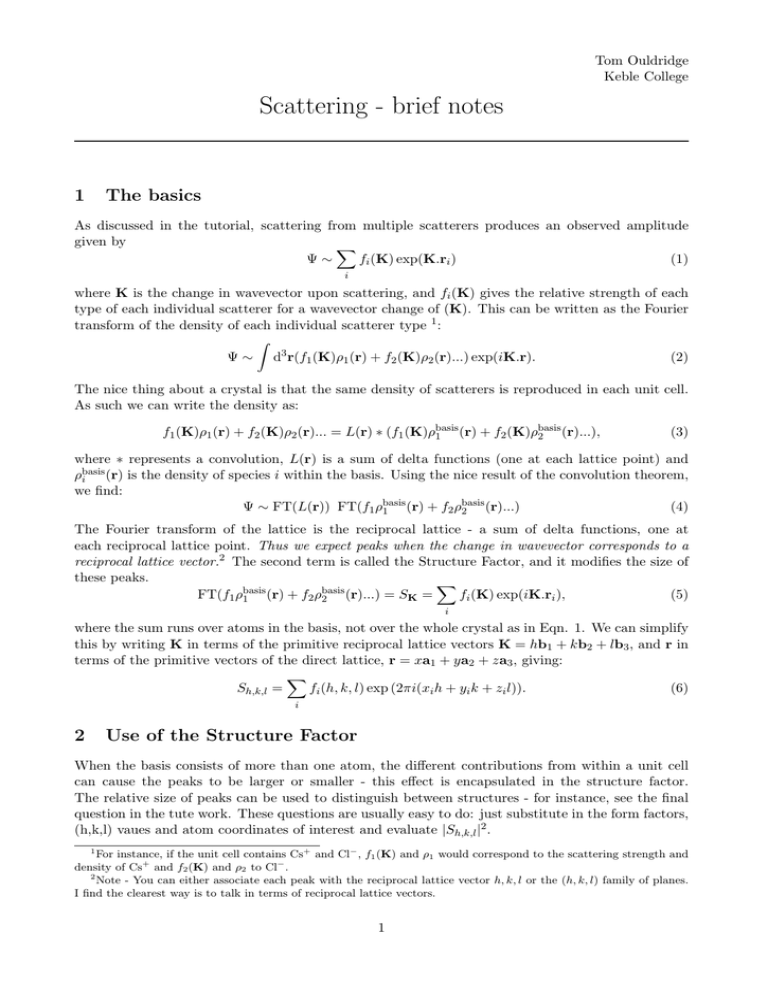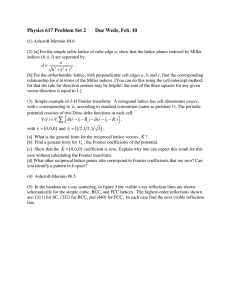Scattering - brief notes
advertisement

Tom Ouldridge Keble College Scattering - brief notes 1 The basics As discussed in the tutorial, scattering from multiple scatterers produces an observed amplitude given by X Ψ∼ fi (K) exp(K.ri ) (1) i where K is the change in wavevector upon scattering, and fi (K) gives the relative strength of each type of each individual scatterer for a wavevector change of (K). This can be written as the Fourier transform of the density of each individual scatterer type 1 : Z Ψ ∼ d3 r(f1 (K)ρ1 (r) + f2 (K)ρ2 (r)...) exp(iK.r). (2) The nice thing about a crystal is that the same density of scatterers is reproduced in each unit cell. As such we can write the density as: f1 (K)ρ1 (r) + f2 (K)ρ2 (r)... = L(r) ∗ (f1 (K)ρbasis (r) + f2 (K)ρbasis (r)...), 1 2 (3) where ∗ represents a convolution, L(r) is a sum of delta functions (one at each lattice point) and ρbasis (r) is the density of species i within the basis. Using the nice result of the convolution theorem, i we find: Ψ ∼ FT(L(r)) FT(f1 ρbasis (r) + f2 ρbasis (r)...) (4) 1 2 The Fourier transform of the lattice is the reciprocal lattice - a sum of delta functions, one at each reciprocal lattice point. Thus we expect peaks when the change in wavevector corresponds to a reciprocal lattice vector.2 The second term is called the Structure Factor, and it modifies the size of these peaks. X FT(f1 ρbasis (r) + f2 ρbasis (r)...) = SK = fi (K) exp(iK.ri ), (5) 1 2 i where the sum runs over atoms in the basis, not over the whole crystal as in Eqn. 1. We can simplify this by writing K in terms of the primitive reciprocal lattice vectors K = hb1 + kb2 + lb3 , and r in terms of the primitive vectors of the direct lattice, r = xa1 + ya2 + za3 , giving: X Sh,k,l = fi (h, k, l) exp (2πi(xi h + yi k + zi l)). (6) i 2 Use of the Structure Factor When the basis consists of more than one atom, the different contributions from within a unit cell can cause the peaks to be larger or smaller - this effect is encapsulated in the structure factor. The relative size of peaks can be used to distinguish between structures - for instance, see the final question in the tute work. These questions are usually easy to do: just substitute in the form factors, (h,k,l) vaues and atom coordinates of interest and evaluate |Sh,k,l |2 . For instance, if the unit cell contains Cs+ and Cl− , f1 (K) and ρ1 would correspond to the scattering strength and density of Cs+ and f2 (K) and ρ2 to Cl− . 2 Note - You can either associate each peak with the reciprocal lattice vector h, k, l or the (h, k, l) family of planes. I find the clearest way is to talk in terms of reciprocal lattice vectors. 1 1 3 Distinguishing different cubic structures It is convenient to analyze cubic crystals using conventional cells. In the case of BCC and FCC, this entails pretending that you have a primitive cubic lattice with a basis of two and four atoms respectively, even though in fact all atoms are associated with a lattice point. If you substitute the coordinates of the BCC and FCC ‘effective’ bases into the equation for the structure factor, you should find that many of the primitive cubic peaks vanish. In fact, BCC peaks only survive if h + k + l is even, and FCC peaks if h, k, l are all either odd or even. This allows you to work out the relative sizes of |K|2 that you would expect to see in the 3 cases (you should do this for yourself and remember it). Of course, to be of any use we must actually compare to experiment. Generally, experimental results give us the wavelength used and the angles at which peaks are observed. We can use Bragg’s law to calculate the separation of planes (dh,k,l ) corresponding to each peak, and then the result from question 2 to infer the size of the reciprocal lattice vector for each peak. |τh,k,l | = 2π dh,k,l (7) Comparing the relative sizes of observed peaks to those predicted by the structure factor for each lattice type allows the lattice to be identified. 4 Slightly complicated structures Consider NaCl – this has an FCC structure with a basis of Na+ (0,0,0), Cl− (1/2,0,0). Working in the conventional cell, our ‘effective’ basis therefore has 8 atoms, which would give a messy structure factor if you tried to do it all at once. Alternatively, we can be a bit clever - let us return to Eqn. 3. Now instead of bunging all 8 atoms in our ‘effective’ basis into the second bracket, we can instead remember that our real basis has only two atoms, and keep the lattice explicitly as FCC for now. If you think carefully, you should be able to see that the lattice can be written as: LFCC (r) = Lprimitive (r) ∗ BFCC (r), (8) in which BFCC is simply a delta function at each of the lattice sites that we want to include in our ‘effective’ basis. Using the convolution theorem again, we find: Ψ ∼ FT(Lprimitive (r)) FT(BFCC (r)) FT(Actual basis). (9) The nice thing here is the pretend and actual parts of the basis are kept separate, making it easier to analyze and understand scattering results. Another way of saying this is that the structure factor Sh,k,l = FT(BFCC (r)) FT(Actual basis) factorizes into a term due to the ‘pretend’ lattice basis and the actual basis which is repeated at each FCC lattice point. X X Sh,k,l = exp (2πi(xj h + yj k + zj l)) fi (h, k, l) exp (2πi(xi h + yi k + zi l)) . (10) j i In the above equation, the sum over j runs over the lattice points in the ‘pretend’ basis and the sum over i the atoms in the real basis. 5 Multiplicity If you do a powder diffraction experiment, you would expect to see rings of diffracted radiation at all angles that satisfy: 2π |K| = , (11) dh,k,l 2 because all possible orientations of the crystal are present in the sample. This means that many different grains will be contributing to the rings – the scattering from these grains will be incoherent (as they are far apart on the length scale of the radiation), and so their intensities will simply add. Let’s say way are observing a ring which corresponds to a K of (1,2,3). In a cubic system with a well-behaved basis (including all examples I have seen in exams), one can think of this ring as having equal contributions from (2,1,3), (3,1,2) ... reciprocal lattice vectors. Thus its intensity will be proportional to the number of equivalent reciprocal lattice vectors you can construct - this factor is known as the multiplicity. 6 Atomic form factors and Lorentz factors If you want to get really involved in calculating structure factors, for x-rays you can treat electrons themselves as the basic scatterers. If you assume electrons scatter uniformly in all directions, then you can go back to Eqn. 2 and take Z Ψ ∼ d3 rfe ρe (r) exp(iK.r) (12) which ends up giving you the Fourier transform of the electronic density around an atom/ion as the form factor fi (K) that you would have used had you treated the atom/ion as the basic unit of scattering. Unfortunately this is not quite the whole story - Thompson Scattering is not actually independent of angle, as the direction that the electron is accelerated by the radiation affects its emission. This results in an extra factor multiplying the intensity of ((1 + cos2 (2θ))/2), which is known as the Lorentz factor. 3





